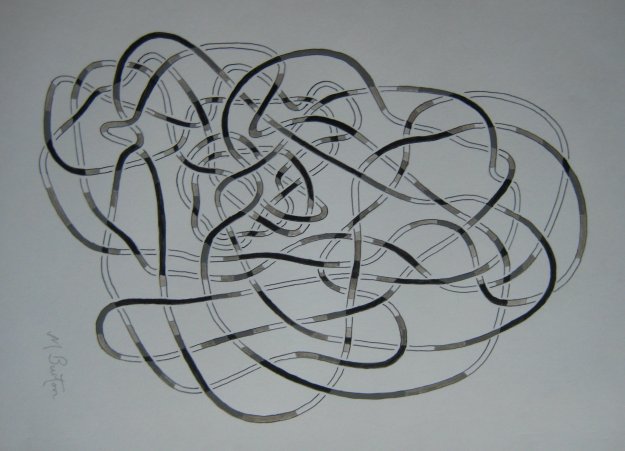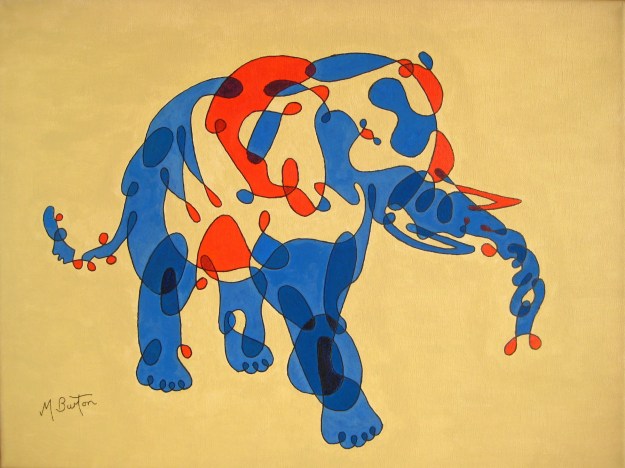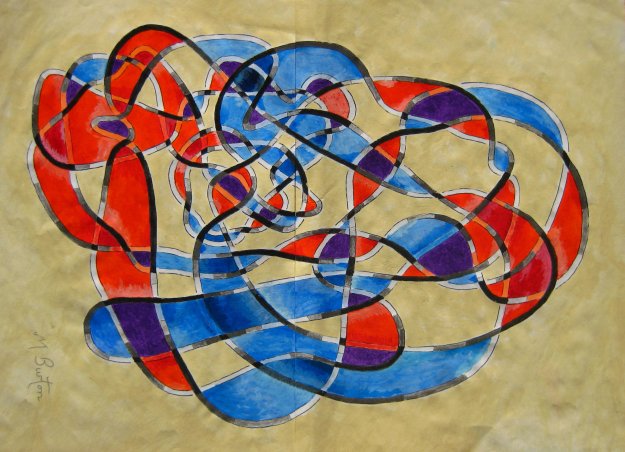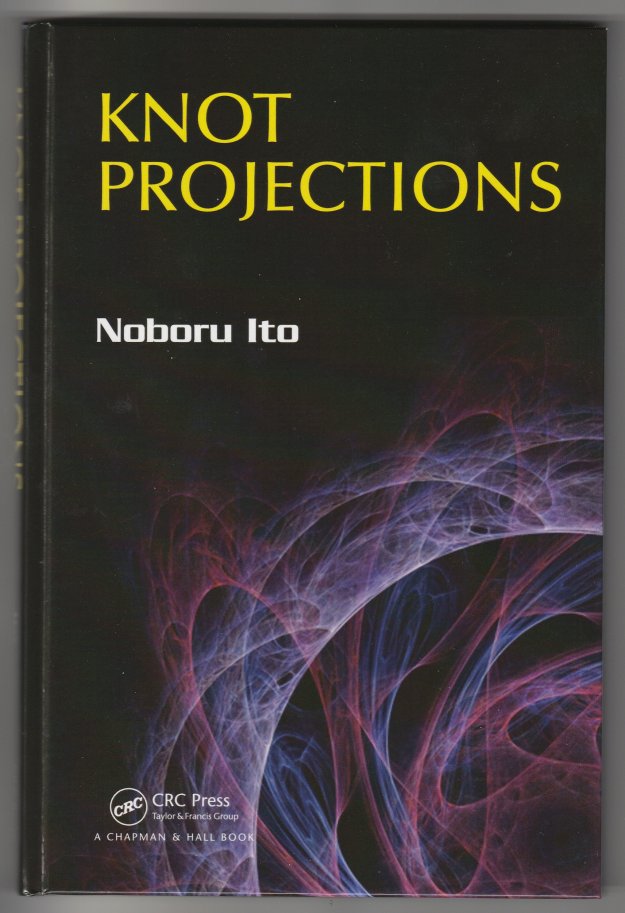
Depth of lines in black and white, in Haken’s Gordian Knot. Mick Burton, single continuous line drawing 2015.
Here is an update on posts which I did in May and June 2015 regarding the above Knot and the interest these posts have since generated.
As a Continuous Line Artist I have looked at many angles of what my lines may mean and what they can do.
One such examination was triggered by Haken’s Gordian Knot, a complicated looking knot which is really an unknot in disguise – a simple circle of string (ends glued together) making a closed line, which I saw in a book called “Professor Stewart’s Cabinet of Mathematical Curiosities”. The drawing above is my version of Ian Agol’s illustration of the Haken Knot (see it in my post of 31 May 2015). I used dark and light shades to emphasize the Overs and Unders shown for the line.
The reason that I was so interested was that it reminded me of my “Twisting, Overlapping, Envelope Elephant” (see below).

This single continuous line drawing is coloured to represent a “Twisting, Overlapping, Envelope Elephant”, which is Blue on one side and Red on the other. Mick Burton, 2013.
How this elephant line works is explained in my post of 31 May 2015. In essence, you need to imagine that the composition is made up of a flexible plastic sheet which is Blue on the front and Red on the back. Each time there is a twist, on an outer edge in the drawing, you see the other colour.
In the Gordian Knot, I spotted that there is a narrow loop starting on the outside (lower left on first illustration above) which seemed to lead into the structure, with its two strands twisting as it went, each time in a clockwise direction. I followed the two twisting lines throughout the drawing until they ended in a final loop on the outside (left higher). I counted 36 clockwise twists and one anticlockwise. My thoughts are explained in full in my post of 2 June 2015.
To aid the explanation I completed a painted version, where I used the same Blue and Red colours, as for the above elephant, to emphasize the twists.

Twisting, overlapping colouring of Haken’s Gordian Knot. Mick Burton, single continuous line drawing painting 2015.
Note that the colours in the Elephant define two sides of a surface, but in the Unknot the colours are illustrating the twist of two lines travelling together. The twin lines go through other loops continually so there are no real surfaces.
After completing the above two posts, I decided that I would try and find out more about the Knot and came across a question posed by mathematician Timothy Gowers, in January 2011, on the MathOverflow website. He had asked for examples of very hard unknots and after many answers he had arrived at Haken’s “Gordian Knot”. He described the difficulties he was having. Timothy said that he would love to put a picture of the process on the website and asked for suggestions.
As I had already done two pictures before I read his post I decided to respond. The work that I did on this is detailed in my post of 5 June 2015 entitled “How do you construct Haken’s Gordian Knot?”.
My response duly appeared on the MathOverflow website in early 2015, but within a day or two it had been taken down and a notice appeared stating that only mathematicians of a certain status should post on the site.
That’s fine as my only maths qualification is General Certificate of Education at school. At Harrogate Technical College I was thrown out of Shorthand and, with only three months to go to GCE exams they put me in for Maths and Art. I owe many thanks to the Shorthand teacher, who thought my only skill was picking locks when someone forgot their locker key. Also I have never had any discussion face to face with a mathematician about my art or my maths.
Following this setback I decided to set it all down in my Blog, in the three posts up to 5 June 2015.
Although I have not actually talked directly to a mathematician, I did correspond with Robin Wilson and Fred Holroyd at the Open University in the mid 1970’s about my ideas on the Four Colour Map Theorem. I set out my ideas briefly in my post of 18 August 2015 “Four Colour Theorem continuous line overdraw”.
When Fred Holroyd responded to my write up, he used my own expressions and definitions which was very impressive. He said that I had proved a connected problem, only proved in the world as recently as 16 years previously. When I asked Robin Wilson about the announcement from a mathematician who said that he had proved the Four Colour Theorem, Robin said not to worry as he thought that this one was unlikely to be validated. He said that he would prefer that my theory could be proved as it was elegant and also that they could use it.
The theorem was proven in 1976 by Kenneth Appel and Wolfgang Haken, involving running one of the biggest computers for over 1000 hours. After this I decided to go onto other things, leaving my art and maths behind for almost 40 years.
Yes, its the very same Wolfgang Haken, who devised the Gordian Knot!
Ok, lets move on. In February 2016 I received an e-mail from Noboru Ito, a mathematician in Japan, saying that he had read my article of 5 June 2015 “How do you construct Haken’s Gordian Knot?” and it was very helpful. He would like to add it to the reference of his new book “Knot Projections”.
Of course I agreed and he later confirmed that he had referenced my work to the preface of his book.
Here is a picture of my copy of his book which was published in December 2016.

“Knot Projections” by Noboru Ito, published December 2016 by CRC Press, a Chapman & Hall Book.
Additionally, in November 2017 I received an e-mail from Tomasz Mrowka, a mathematician at the Massachusetts Institute of Technology. He said that he was interested in acquiring a copy of my Twisting, Overlapping colouring of Haken’s unknot. “It’s really quite striking and I would love to hang it in my office”.
I was delighted to send him a photo which he could enlarge and frame.




